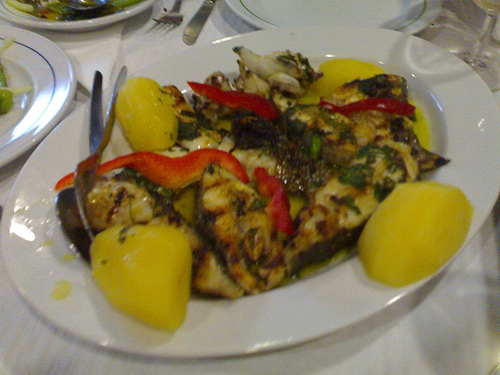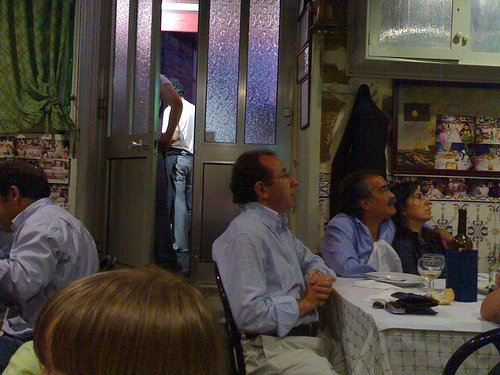You know those reality TV shows where cameras shoot a sort of “day in the life” of an airport? There’s one that’s shot at Heathrow that airs in Canada; every episode focuses on one or two little plots — someone trying to smuggle head cheese into the country, or a VIP flying in for the day, or a 12 hour delay on the flight to Australia. We’re taken “behind the scenes” and shown how the airport system deals with its everyday challenges.
Well, on Friday, flying through London Stansted, we became one of those stories; but for the lack of television cameras following us around, we’d have fit right into the exciting airport drama.
We had a six hour layover at Stansted. The first 3 hours were spent huddling against a wall on three “seen better days” chairs (Stansted’s pre-security areas are woefully lacking in chairs), having a little lunch, some fresh-squeezed juice from the juice bar, and generally trying to not perish from the exhaustion of already having woken up at 6:00 a.m. and flown in from Portugal.
Around 3:30 p.m. we were finally allowed to check in for our 6:15 p.m. easyJet flight to Copenhagen, and once we’d checked in, and loaded Oliver’s car seat through the oversized bagged chute, we went through security and headed over to Pret a Manger for some sushi.
Just as we were about finished up our lunch, Oliver started to rub his right eye. We didn’t pay attention for the first bit, but after he started complaining that his eye was hurting, Catherine took a closer look: turns out his eye was a little puffy, and looked like maybe he had something in it. I headed over to the washroom with him to see if we could wash his eye out; by the time we got there, his eye was very puffy, and surrounded by white puffy hives. A kindly baggage agent passing by noticed my obvious distress, and told us that if we tracked down a green-jacketed security guard, they could connect us with the airport’s medical team.
We stopped back to tell Catherine where we were headed, and then went off in search of the green jacketed.
While I’m certain that we saw many such green jacketed people on the way in, there were none at all in evidence as we walked around. We eventually came upon the “airline information” desk, and the clerk there let us borrow the telephone to call the emergency hotline (222 if you ever need it).
The emergency operator — presumably the same person you call if your plane is on fire or you’re having a heart attack — was very capable, took my details, and said she would dispatch a first aid officer shortly, and that we should stay where we were.
About 5 minutes later (it was probably 2 minutes, but felt like 5) said first aid officer — about the single most helpful man I’ve ever met in my life — was on the scene, looked at Oliver’s eye, and suggested we come in to the on-site medical clinic for an examination by a paramedic. He went off to fetch Catherine — by this time thinking the worst, of course — and then ferried us back through security (with promises to “fast track” us back the other way) and into a rabbit warren of little rooms behind an “airport personnel only” door.
And there in a little room that looked much like a doctor’s office, we found Peter the Scottish Paramedic, perhaps the second most helpful man I’ve ever met in my life. He gave Oliver a thorough going over — checked his airway, looked at his eye, listened to his breathing — and suggested that our best course of action would be to get some antihistamine from the airport pharmacy to see if that would help (the fact that Oliver was not otherwise in distress, and could breath normally, appeared to suggest he was not in imminent danger).
So while Catherine and Oliver stayed with Paramedic Pete, the first aid officer and I headed out into the airport to find the pharmacy.
When we arrived at the pharmacy the pharmacist was in the middle of some highly complex operation involving sticky tape. It turns out that the customer ahead of us was ordering what looked like a lifetime supply of some medicine or another, the label printer was broken, and the pharmacist was forced to hand-make and hand-apply individual labels on about 25 little boxes.
Reasoning that if I flipped out I would lose the support of the helpful first aid man (and the pharmacist), I calmly waited for 15 minutes while the sticky tape was applied. When this operation was over, the pharmacist listened to our tale, and immediately pulled a bottle of Piriton syrup from the shelf and told me how to dose it.
Then it was back to the rabbit warren to check on Oliver and give him the healing solution. By the time we returned his eye puff had subsided considerably, and the around-the-eye hives were gone. Catherine and Paramedic Pete, meanwhile, had deduced the likely source of the puffiness: the fresh squeezed orange juice Oliver had consumed earlier in the day. Apparently this was the 3rd or 4th report the paramedic had handled that could be traced back to the same retailer’s juice; his assumption was that some sort of spore or fungus on the orange was the culprit. He immediately placed a call to the juice place to warn them.
With a dose of Piriton in his belly (and a warning that it would knock him out — which it never did), we were indeed fast tracked back through security, huffed our way to the train to the gate, and as we came up the escalator the “passengers traveling with small children” announcement for our flight came over the PA.
Oliver was quite happy and normal by this point, and over the last 36 hours his eye has gradually returned to its normal state.
While the situation turned out to be not-so-serious, I still wouldn’t wish it on anyone. That said, it was nice to know that a team was waiting behind the scenes ready to deal with all that life could throw at the airport. Our heartfelt thanks go out to Paramedic Pete and nameless helpful first aid man (who turned out to be also responsible for elevators and myriad other airport quirks).
Oliver, of course, is never going to eat or drink another thing if I have any say in the matter.


